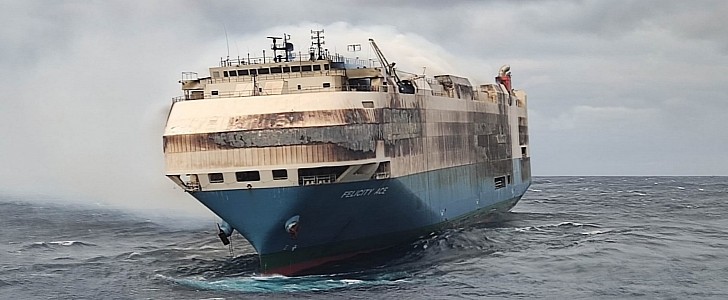You’ll remember that the cargo ship Felicity Ace caught fire on February 16 near the Azores. On March 1, it sank in the Atlantic ocean, taking the remains of 3,965 cars with it. Most of them were from the Volkswagen group, and we’ll probably never know exactly which cars were lost unless the carmaker reveals that. However, at least 281 of them were electric cars, which made fighting the fire harder. And that will not be the only legacy from this episode.
According to Splash, the company that owned Felicity Ace decided it would not transport used electric vehicles anymore. MOL (Mitsui OSK Lines) said that used ICE vehicles allowed for an assessment of fire risks, such as searching for leaks and short circuits. Electric cars do not offer that possibility: if a thermal runaway starts inside a battery pack, you’ll only notice it when it is already too late. Besides, nobody ever presented a way to prevent it.
It is curious that MOL claims this has nothing to do with the Felicity Ace fire. According to Splash, the Japanese carrier joined a list of other companies that decided against transporting used electric cars. It makes sense: all the 281 electric vehicles that the ship was carrying before it caught fire were brand new.
The manifests published by importinfo.com show that the Felicity Ace had 121 Audi e-tron, 1 e-tron GT, and 159 Volkswagen ID.4 units. Porsche should have a large number of Taycans on the ship as well, but the manifests do not discriminate the vehicles from the company that were being taken from Germany to the U.S.
They only say that Porsche had 558 unspecified vehicles inside the cargo ship. To give you an example of how confusing the manifests are, they say that there were 30 Porsche Cayenne, Macan, and Panamera there in total. We have no idea how many units of each of these models were there.
Concerns with lithium-ion batteries are not new. The fire risk they present made it very difficult to transport them in the past, something that Tesla and Korean companies seem to have overcome by exporting their EVs so frequently. The problem is that the Felicity Ace fire shows fire-extinguishing methods in ships carrying EVs have to be radically different than those used for common cargo.
When a battery pack catches fire, the oxides in the chemistry of the cells make them generate the oxygen the blaze needs to keep alive. That makes any fire involving EVs more challenging to put down, even if EVs are not as subject to fires as vehicles carrying fuel. According to Splash, the Hyundai Glovis carrier is studying with Korean Register new methods, such as transporting EVs covered with special fire-resistant blankets.
One thing is for sure: after the Felicity Ace decided to rest at the bottom of the Atlantic after burning for days without any possibility of control, cargo ship owners will follow other procedures for transporting electric cars. We’ll hear about them soon enough.
It is curious that MOL claims this has nothing to do with the Felicity Ace fire. According to Splash, the Japanese carrier joined a list of other companies that decided against transporting used electric cars. It makes sense: all the 281 electric vehicles that the ship was carrying before it caught fire were brand new.
The manifests published by importinfo.com show that the Felicity Ace had 121 Audi e-tron, 1 e-tron GT, and 159 Volkswagen ID.4 units. Porsche should have a large number of Taycans on the ship as well, but the manifests do not discriminate the vehicles from the company that were being taken from Germany to the U.S.
They only say that Porsche had 558 unspecified vehicles inside the cargo ship. To give you an example of how confusing the manifests are, they say that there were 30 Porsche Cayenne, Macan, and Panamera there in total. We have no idea how many units of each of these models were there.
Concerns with lithium-ion batteries are not new. The fire risk they present made it very difficult to transport them in the past, something that Tesla and Korean companies seem to have overcome by exporting their EVs so frequently. The problem is that the Felicity Ace fire shows fire-extinguishing methods in ships carrying EVs have to be radically different than those used for common cargo.
When a battery pack catches fire, the oxides in the chemistry of the cells make them generate the oxygen the blaze needs to keep alive. That makes any fire involving EVs more challenging to put down, even if EVs are not as subject to fires as vehicles carrying fuel. According to Splash, the Hyundai Glovis carrier is studying with Korean Register new methods, such as transporting EVs covered with special fire-resistant blankets.
One thing is for sure: after the Felicity Ace decided to rest at the bottom of the Atlantic after burning for days without any possibility of control, cargo ship owners will follow other procedures for transporting electric cars. We’ll hear about them soon enough.







